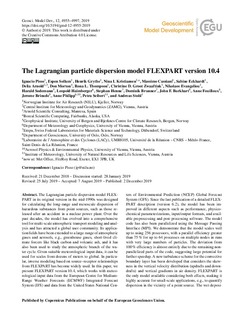| dc.description.abstract | The Lagrangian particle dispersion model FLEXPART in its original version in the mid-1990s was designed for calculating the long-range and mesoscale dispersion of hazardous substances from point sources, such as those released after an accident in a nuclear power plant. Over the past decades, the model has evolved into a comprehensive tool for multi-scale atmospheric transport modeling and analysis and has attracted a global user community. Its application fields have been extended to a large range of atmospheric gases and aerosols, e.g., greenhouse gases, short-lived climate forcers like black carbon and volcanic ash, and it has also been used to study the atmospheric branch of the water cycle. Given suitable meteorological input data, it can be used for scales from dozens of meters to global. In particular, inverse modeling based on source–receptor relationships from FLEXPART has become widely used. In this paper, we present FLEXPART version 10.4, which works with meteorological input data from the European Centre for Medium-Range Weather Forecasts (ECMWF) Integrated Forecast System (IFS) and data from the United States National Centers of Environmental Prediction (NCEP) Global Forecast System (GFS). Since the last publication of a detailed FLEXPART description (version 6.2), the model has been improved in different aspects such as performance, physicochemical parameterizations, input/output formats, and available preprocessing and post-processing software. The model code has also been parallelized using the Message Passing Interface (MPI). We demonstrate that the model scales well up to using 256 processors, with a parallel efficiency greater than 75 % for up to 64 processes on multiple nodes in runs with very large numbers of particles. The deviation from 100 % efficiency is almost entirely due to the remaining nonparallelized parts of the code, suggesting large potential for further speedup. A new turbulence scheme for the convective boundary layer has been developed that considers the skewness in the vertical velocity distribution (updrafts and downdrafts) and vertical gradients in air density. FLEXPART is the only model available considering both effects, making it highly accurate for small-scale applications, e.g., to quantify dispersion in the vicinity of a point source. The wet deposition scheme for aerosols has been completely rewritten and a new, more detailed gravitational settling parameterization for aerosols has also been implemented. FLEXPART has had the option of running backward in time from atmospheric concentrations at receptor locations for many years, but this has now been extended to also work for deposition values and may become useful, for instance, for the interpretation of ice core measurements. To our knowledge, to date FLEXPART is the only model with that capability. Furthermore, the temporal variation and temperature dependence of chemical reactions with the OH radical have been included, allowing for more accurate simulations for species with intermediate lifetimes against the reaction with OH, such as ethane. Finally, user settings can now be specified in a more flexible namelist format, and output files can be produced in NetCDF format instead of FLEXPART's customary binary format. In this paper, we describe these new developments. Moreover, we present some tools for the preparation of the meteorological input data and for processing FLEXPART output data, and we briefly report on alternative FLEXPART versions. | nb_NO |

